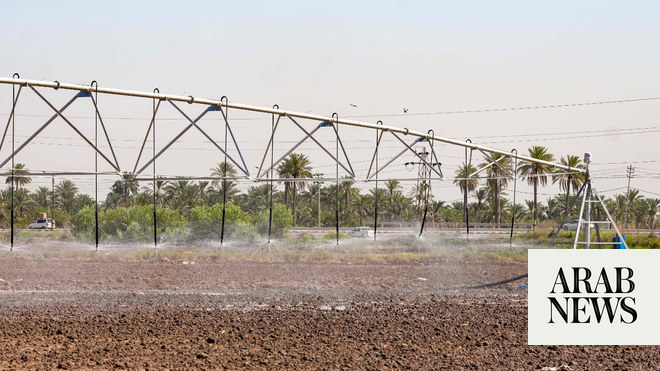NAJAF, Iraq: Seeing his once lush rice fields shrink in recent years due to severe drought, Iraqi farmer Muntazer Al-Zoufi has been fighting back by using hardier seeds and water-saving irrigation techniques.
“This is the first time I have used modern technology that uses less water to grow rice,” said 40-year-old Joofi, surveying his land in the central province of Najaf.
“There is a huge difference” compared to watering fields, Joufi said, referring to traditional methods that require the soil to be kept under water throughout the summer.
But four years of drought and reduced rainfall have led to a decline in rice production in Iraq, a country still recovering from years of war and chaos, where rice and bread are staples.
The United Nations says Iraq is one of the five countries in the world most vulnerable to climate change.
Joofi is one of the farmers receiving support from the Ministry of Agriculture who has been developing innovative methods to save Iraq's rice production.
Their research involves combining resilient rice seeds with modern irrigation systems to replace flooding methods in countries struggling with water shortages, heat and diminishing river flows.
Under the hot Iraqi sun, with temperatures nearing 50 degrees Celsius (122 degrees Fahrenheit), Joofy walked slowly across the muddy field, pausing to repair broken sprinklers that littered his one-hectare (2.5-acre) plot.
A typical rice crop in Iraq requires 10 to 12 billion cubic meters of water over a five-month growing season.
But experts say the new method, using sprinklers and drip irrigation, uses 70 percent less water than traditional flood irrigation, which requires workers to completely submerge fields in water.
Now, “if one person turns on the sprinkler… the water reaches every part of the ground,” Jupi said.
Agriculture Department experts said the area planted to rice was reduced from 30,000 hectares to just 5,000 hectares in the years when the drought continued.
“Drought and water shortages require us to use modern irrigation technologies and new seeds,” said Abdel Kazem Jawad Moussa, who leads the team of experts.
They experimented with five types of seeds that could withstand drought and reduce water use, several types of sprinklers, and drip irrigation systems to find the best combination.
“We want to know which seed genotypes respond well to sprinkler irrigation instead of flooding,” Musa said.
Last year, experts had good results when growing Al-Ghari, a genotype derived from Iraq's precious pumpkin rice, and South Asian jasmine seeds in small sprinklers, so they suggested that farmers like Jupi combine the two, hoping for the best results.
“We will make recommendations at the end of the season,” Musa said, adding that he hopes to introduce three new seeds next year that will shorten the planting season.
In addition to the drought, authorities blame dams built upstream by Iraq's powerful neighbors Iran and Turkey for rapidly dropping water levels in the Tigris and Euphrates rivers, which have irrigated Iraq for thousands of years.
Water shortages have forced many farmers to abandon their lands, and authorities have drastically reduced farming activities to ensure Iraq's 43 million people have enough drinking water.
Authorities have capped rice cultivation in Najaf and the southern province of Diwaniyah, the epicenter of amber rice cultivation, at 1,000 hectares in 2022.
Farmers in Diwaniya recently staged a protest, urging the government to allow them to resume farming after a two-year hiatus.
But although abundant rains this winter have eased water shortages, authorities have only allowed rice farming on 30 percent of the country's land.
“The best year was 2020,” said farmer Fayez Al-Yassiri from his field in Diwaniyah, where he plans to grow amber and jasmine rice.
Iraq is the second-largest oil producer in the OPEC cartel, but despite its vast oil and gas reserves, it still relies on imports to meet its energy needs and faces chronic power outages.
Yasiri urged authorities to provide concrete support to farmers, including providing electricity and pesticides.
His cousin Bassem Yasiri was less hopeful. “The lack of water has ended agriculture in this area,” he said.
